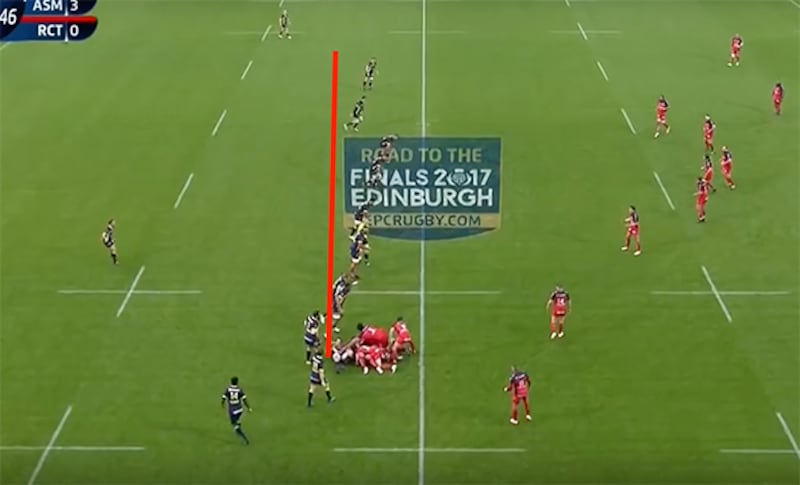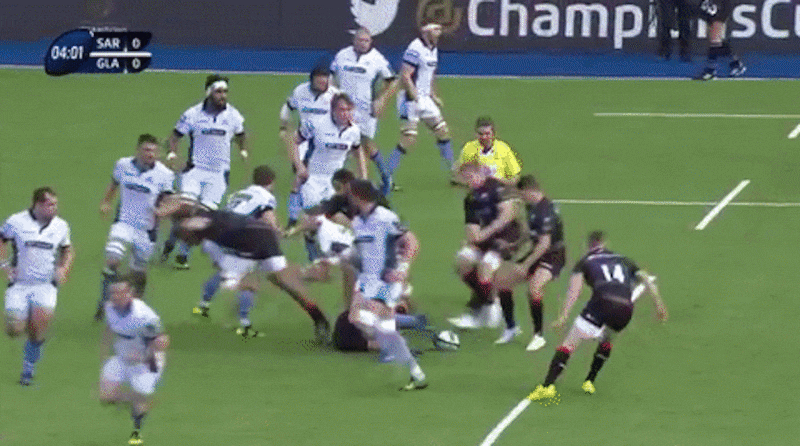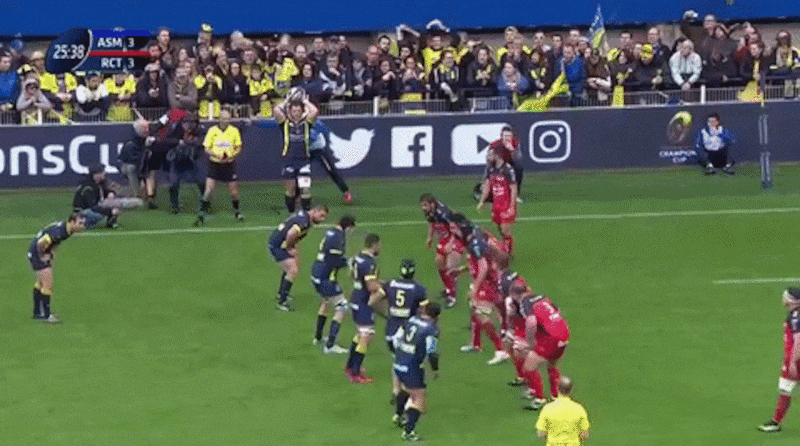By now, the Leinster and Munster coaches will have shown their players ways in which to navigate around Clermont and Saracens.
The onus isn’t on the French or English doing anything different. And they won’t because they know their blueprint, their styles of play, should be enough to reach the final.
So Leinster and Munster will have to conjure up something special.
This quest can begin by looking at how Glasgow and Toulon failed to produce enough moments of creativity or innovation to catch either of them out in the Champions Cup quarter-finals.
Toulon were incredibly inaccurate, ponderous and Leigh Halfpenny missed some crucial kicks at goal. Their sheer size and quality of player allowed them stay with Clermont. But on the hour mark, with the score 9-9, Clermont pounded into the 22 with runner after heavy runner before the composure of Morgan Parra, Ludovic Radosavljevic and Camille Lopez allowed Noa Nakaitaci skate over for the decisive try.

All those carries will condense any defence. Parra and Lopez recognised this and delivered the killer blow to Toulon.
In contrast to the other semi-finalists, Parra at scrumhalf runs the show more than Lopez at ten. Owen Farrell's influence at Saracens is similar to how Johnny Sexton's fingerprints are to be found all over the Leinster attack. Same goes for Munster's Tyler Bleyendaal who in Conor Murray's absence takes on an even greater role.
Constantly offside
In what will probably be very close games, the control and decision making of these men should decide the outcomes.
Leinster will also need Nigel Owens to ensure the situation Wayne Barnes allowed to develop at Marcel Michelin in the quarter-final does not reoccur in Lyon.
Clermont were constantly offside for the opening 15 minutes.

I’m not sure if Toulon complained but I have no doubt that Johnny and Sean O’Brien will be straight into Nigel’s ear. The herd mentality, if we are all offside he can’t ref it, must not be allowed to prevail as Leinster need every legal blade of grass to puncture holes in the Clermont line.
The same applies to Munster in Dublin but at least Glasgow showed them precisely what not to do. Gregor Townsend’s team played directly into Saracens ginormous hands by constantly coming around the corner without a decoy runner or even a hint of the creativity that got them there in the first place.
Saracens have a very specific way of beating teams. A rapid supply of possession from two-second rucks is facilitated by the artificial pitch in Allianz Park. If Munster can slow that supply to three- or four-second rucks it might disrupt the timing of runners. That is possible on the natural Aviva Stadium pitch.
Achieving that would almost make the English champions look ordinary but slowing their ball is no easy task.
So a statement needs to be made in the early breakdowns. Glasgow couldn’t get close to them. It took Saracens four minutes to soften them up and beat them on the outside. Now, Sean Maitland’s try was disallowed as the TMO showed Stuart Hogg tackled him into touch but the point stands.

This is the blueprint for how Saracens play: ball off the lineout, torpedo Brad Barritt at the defence, secure rapid ball for Farrell who goes wide to the second distributor, where Alex Goode puts the winger away.
All three passes before Goode gets the ball – Jamie George to Farrell to Chris Ashton – go backwards but each time the receiver is threatening to breach the gain line.
Munster, like most teams attacking off phase play, have to go about 20 yards backwards to find space out wide. Not Saracens. They can be creative in the collision zone because of their ruck speed.
This is why Ashton plays so well for them. He pops up in a hybrid Rugby League/union role that allows him disguise his running line off Farrell and straighten before feeding Goode.
Evolutionary ladder
The timing of their attack is so precise but Saracens are at the peak of their evolutionary ladder and only a flawless Munster performance can stop them.
Rassie Erasmus has them on an incredible upward trajectory since late October but they have a long way to go before they get to where Erasmus intends to leave them, providing he does not return to South Africa for another two years.
Saracens are already where they intended to be; the dominant club in England and European champions. They have been in the hard fights and prevailed. Their culture is cemented. They trust each other, there’s a strong leadership core.
Anything short of victory on Saturday would be seen as failure. This is not England coming to face Ireland, Saracens are a far more intimidating proposition.
Munster must take a huge leap in performance just to live with them. Sarries destroy conservative sides so the attitude has to be: attack, smartly, and with accuracy.
Of course Conor Murray is a huge loss but I see the advantage of Jaco Taute’s defensive qualities and Francis Saili’s attacking flair being facilitated together for this game.
Defensively it certainly makes sense. Taute can more than handle Barritt or whoever is launched at the line off first phase. Taute standing at inside centre in defence – with Rory Scannell, if fit, given an important impact role in the last quarter – makes sense because to defend the Rugby League directness you need someone waiting in the space to severely hurt the ball carrier.
Taute is made for that collision zone. If I was looking for one chink in the Saracens team – how to flip a primary weapon and use it against them – I would single out Barritt. Make him make decisions. He rarely passes so punish his carries. Make him the pantomime villain. Give him the Sébastien Chabal treatment.
Also, and this is key, the Munster back three must outclass the Sarries trio of Goode, Ashton and Maitland. All three are stunning attacking players but none of them like tackling (Ashton’s positioning is poor and he ends up in bad tackle scenarios).
Punishing phases
Clermont are not as reliable as Saracens but Munster’s odds in Dublin must be far more appealing to the neutral than a Leinster victory.
Parra is playing as well as he ever has. Lopez does run the attack off set plays but Parra steers the ship as the phases build into double figures. And that’s what Clermont are guaranteed to do: punishing phases, huge men carrying at pace, before Parra and/or Lopez unlock the defence with clever distribution or chip kicks.
They are a tough side to defend off set piece because of the angled running of powerful men like Aurélien Rougerie and Nick Abendanon.
Robbie Henshaw against Rémi Lamerat is going to be a very important battle. In the past six months alone, Henshaw and Garry Ringrose have faced challenges that some centre pairings need a decade to not only cope with but ever come across. Henshaw and Ringrose have come up against everyone but the All Blacks (who they both faced alongside Jared Payne), and each time they have come out looking better than people perceived them to be beforehand.
Their task on Sunday is to get in amongst Lamerat and Rougerie. Garry must stress the elder statesman at every opportunity.
As Clermont's defensive intensity shows, be it illegal or not, there's a renewed hunger in their approach. I am sure Jono Gibbes has had a significant role in creating that.
I have enormous respect for Jono. I played against him when he led the Maori to victory over the Lions in 2005. I think he hit me that night harder than anyone ever did.
Jono is the type of guy who drinks coffee straight from the pot. He arrived at Leinster in 2008 to replace Mike Brewer, another hard old All Black flanker, with no experience to speak of yet he instantly commanded the respect of the entire squad. Some guys just have it when they enter a room.
Mike was a really good coach but his ability to deliver the message sometimes got lost. Jono had no such problem. He is the master of the two minute speech. Make three or four key points and sit back down.
The impact tends to be lasting.
Positive influence
He was a very positive influence during a great time to be a Leinster player. That’s almost ten years ago; he can have only grown as a coach.
There are two dogs at the bowl in Lyon. Clermont have the potential to steamroll into another final but I firmly believe Leinster will make it a brutal war. Johnny is fit, Seanie O’Brien is back at full throttle and performing while Joey Carbery brings another dimension to the attack.
Again, semi-finals leave no margin for error. The defensive task will demand that every player is mobile enough to put the multiple Clermont runners to ground. Toulon stayed in the fight for 60 minutes because a flanker, Liam Gill, was able to deny Rougerie the offload to Abendanon.

It doesn’t matter who makes the tackle – be it a prop on winger, whatever, it just has to get done. Otherwise Clermont have the ability to tear Leinster up.
Leinster must outmanoeuvre them but also bring them to a place where they might crack. There are demons in Clermont’s collective mindset.
They have lost more semis and finals than they have won.
All that said, a Munster win in Dublin seems more logical than a Leinster win in Lyon. Yes, Leinster are better stocked, a better team, but winning a semi-final down in France is a task that took my Leinster team until 2012 to achieve. By then we were the defending European champions.
This Leinster side, like Munster, are still on the climb. But anything can happen in these one-off matches. It’s a new chapter for Irish rugby no matter what happens.














